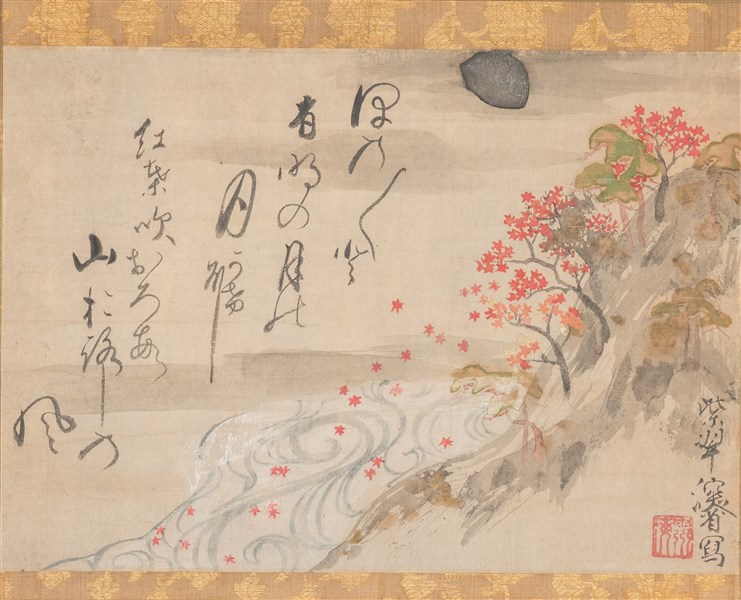紅葉図 尾形乾山筆
- 江戸時代
- 18c
- 紙本墨書著色
- H-30.5 W-43.1
江戸時代 18世紀
紙本著色
縦:30.5cm 横:43.1cm
尾形乾山(1663~1743)は,尾形光琳の弟。前半世は陶工として名高かったが,晩年のはなはだ雅味に富んだ絵画作品も人気を呼んだ。ことに和歌などを散らし書き風に絵のなかにおさめた作品に優れたものが多い。
本図は画面の対角線の下半分に山肌と流水を配する構図をとる。この構図法は兄の光琳も得意としたところで,兄に絵を学んだとされる乾山の絵画修業の一端をうかがわせる。月は伝統に準じて銀泥で処理し,鈍く光らせている。
乾山得意の散らし書きは,『新古今和歌集』源信明の「ほのほのと有明の月の月かけに紅葉吹おろす山をろしの風」である。
一般的には光琳の絵にはどこか鋭ぎすまされた感覚が潜んでいるが,乾山の絵にはむしろわれわれの緊張を解きほぐすような柔らかな感覚がある。 (狩野)
尾形乾山
尾形乾山(おがたけんざん 1663~1743)
乾山は、寛文3年(1663)京都の富裕な呉服商尾形宗謙(おがたそうけん)の三男として生まれました。兄は画家の光琳です。二人の性格は対象的で、光琳が派手好みであったのに対し乾山は内省的、隠遁的な性格の持主であったといわれています。
野々村仁清に陶芸を学んだ乾山は、元禄12年(1699)37歳のとき京都市の鳴滝に開窯しました。そして正徳2年(1712)50歳の乾山は、京市内の二条丁子屋町に移住し、多くの作品を手がけ「乾山焼」として世にもてはやされました。鳴滝時代の末期からこの丁子屋町時代にかけて兄の光琳は絵付で乾山を助け、兄弟合作の作品が数多く残されています。
享保16年(1731)69歳の頃に江戸に下り寛永寺(かんえいじ)領入谷(いりや)に窯を築いて晩年を送りました。そして81歳で没するまで江戸に在住し陶器や絵画の制作に手腕を発揮しました。
乾山の作品は陶芸作品のみならず書や絵画においても、俗気を脱したおおらかで文人的な洒脱味があります。陶芸作品においては成形、施釉、焼成は他の専門的な陶工に任せたり、絵付についても光琳との合作以外に複数の専門画家が携わっていたと思われるなど、基本的には工房生産という態勢をとっていたようです。しかし、乾山の指導のもとにつくられたやきものには、その大胆なデザイン感覚とともに乾山特有の芸術性が溢れ、乾山その人とふれあうような親しみが感じられるのです。
乾山銹絵染付掻落絵替汁次
乾山銹絵染付梅波文蓋物
乾山立鶴図黒茶碗
乾山銹絵染付桔梗図筒向付
乾山銹絵染付草文四方鉢
乾山銹絵染付松図茶碗
乾山色絵短冊皿
乾山銹絵絵替長平皿
乾山色絵寿字輪花向付
乾山銹絵絵替四方皿
乾山銹絵染付絵替筒向付
乾山銹絵染付松図茶碗
乾山色絵椿文向付
乾山銹絵染付春草図茶碗
乾山銹絵染付藤図向付
乾山色絵立葵図向付
乾山色絵雪杉図向付
乾山色絵桔梗文盃台
乾山銹絵馬図香合
乾山銹絵染付絵替扇形向付
乾山銹絵掻落雲唐草文大鉢
乾山銹絵草花波文水指
乾山銹絵染付絵替土器皿
乾山色絵槍梅図茶碗
乾山黒楽梅図茶碗
乾山銹絵染付芙蓉図茶碗
銹絵掻落牡丹唐草文香合
撫子図(尾形乾山筆)
乾山色絵和歌陶板
乾山色絵竜田川図向付
乾山銹絵牡丹画角皿 尾形光琳画
乾山銹絵百合形向付
乾山銹絵松文香合
乾山色絵阿蘭陀写市松文猪口
乾山色絵薄図蓋茶碗
乾山銹絵菊図水指
鶴亀図黒茶碗
三十六歌仙絵/在原業平像 尾形乾山筆
三十六歌仙絵/斎宮女御像 尾形乾山筆
乾山色絵菊文手付汁次
三十六歌仙絵/小野小町像 尾形乾山筆
乾山銹絵染付山水図茶碗
Catalogue Entry
by Ogata Kenzan
Edo period, 18th century
Hanging scroll, color on paper
Height, 30.5cm; width, 43.1cm
Ogata Kenzan (1663-1743) was the younger brother of Ogata Korin. Kenzan was famous in the first half of his life for his work as a potter, and in his later years, he also developed quite a following for his distinctive, refined paintings. There are a considerable number of superb works remaining by Kenzan which combine painting with a waka poem brushed in elegantly scattered calligraphy.
This painting is composed of a mountainside and flowing water stretching diagonally across the lower right-hand corner of the composition. Kenzan's brother Korin was particularly adept at this compositional form, and here Kenzan's use of the device allows us a glimpse of one aspect of Kenzan's painting studies under his older brother. The moon painted in silver paint has tarnished over the years, yet still casts its pure light.
Kenzan's distinctive calligraphy scattered across the upper left of the composition quotes Minamoto-no-Saneakira's poem from the Shinkokin Wakashu anthology about mountain winds gusting through red maple leaves under the moonlight of the moon of Ariake.
In general, Korin's paintings are awash with a somewhat sharp sensibility, while Kenzan's works have a gentleness that seems to soothe the tensions of their viewers. HK
